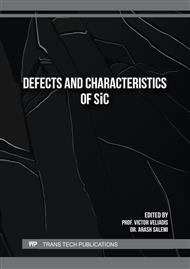[1]
F. Seitz, Prismatic Dislocations and Prismatic Punching in Crystals, Phys. Rev. 79 (1950) 723-724.
DOI: 10.1103/physrev.79.723
Google Scholar
[2]
D.A. Jones, J.W. Mitchell, Observations on helical dislocations in crystals of silver chloride, Philos. Mag.-J. Theor. Exp. Appl. Phys 3 (1958) pp.1-7.
Google Scholar
[3]
L.M. Brown, G.R. Woolhouse, The loss of coherency of precipitates and the generation of dislocations, Philos. Mag.-J. Theor. Exp. Appl. Phys 21 (1970) 329-345.
Google Scholar
[4]
M.F. Ashby, L. Johnson, On the generation of dislocations at misfitting particles in a ductile matrix, Philos. Mag.-J. Theor. Exp. Appl. Phys 20 (1969) 1009-1022.
DOI: 10.1080/14786436908228069
Google Scholar
[5]
G.C. Weatherly, Loss of coherency of growing particles by the prismatic punching of dislocation loops, Philos. Mag.-J. Theor. Exp. Appl. Phys. 17 (1968) 791-799.
DOI: 10.1080/14786436808223030
Google Scholar
[6]
Y. Flom, R.J. Arsenault, Deformation of SiC/Al Composites. JOM 38 (1986) 31-34.
DOI: 10.1007/bf03258711
Google Scholar
[7]
M. Wada, J. Suzuki, Characterization of Te Precipitates in CdTe Crystals, Jpn. J. Appl. Phys. 27 (1988) L972.
DOI: 10.1143/jjap.27.l972
Google Scholar
[8]
A. Giannattasio, A., S. Senkader, R.J. Falster, P.R. Wilshaw, The role of prismatic dislocation loops in the generation of glide dislocations in Cz-silicon, Comput. Mater. Sci. 30 (2004) 131-136.
DOI: 10.1016/j.commatsci.2004.01.021
Google Scholar
[9]
H. Yu, A.C.F. Cocks, E. Tarleton, Formation of prismatic dislocation loops during unloading in nanoindentation, Scr. Mater. 189 (2020) 112-116.
DOI: 10.1016/j.scriptamat.2020.07.062
Google Scholar
[10]
W.W. Webb, C.E. Hayes, Dislocations and plastic deformation of ice, Philos. Mag.-J. Theor. Exp. Appl. Phys. 16 (1967) 909-925.
DOI: 10.1080/14786436708229684
Google Scholar
[11]
Q.Y. Cheng, H.Y. Peng, S.S. Hu, Z.Y. Chen, Y. Liu, B. Raghothamachar, M. Dudley, Ray-Tracing Simulation Analysis of Effective Penetration Depths on Grazing Incidence Synchrotron X-Ray Topographic Images of Basal Plane Dislocations in 4H-SiC Wafers, Mater. Sci. Forum 1062 (2022) 366-370.
DOI: 10.4028/p-2kzz01
Google Scholar
[12]
X.R. Huang, M. Dudley, W.M. Vetter, W. Huang, W. Si, C.H. Carter Jr, Superscrew dislocation contrast on synchrotron white-beam topographs: an accurate description of the direct dislocation image, J. Appl. Crystallogr. 32 (1999) 516-524.
DOI: 10.1107/s0021889899002939
Google Scholar
[13]
X.R. Huang, M. Dudley, W.M. Vetter, W. Huang, S. Wang, C.H. Carter Jr, Contrast Mechanism in Superscrew Dislocation Images on Synchrotron Back-Reflection Topographs, MRS Proceedings 524 (1998) 71.
DOI: 10.1557/proc-524-71
Google Scholar
[14]
M. Dudley, X.R. Huang, W. Huang, Assessment of orientation and extinction contrast contributions to the direct dislocation image, J. Phys. D Appl. Phys. 32 (1999) A139.
DOI: 10.1088/0022-3727/32/10a/329
Google Scholar
[15]
F. Fujie, H. Peng, T. Ailihumaer, B. Raghothamachar, M. Dudley, S. Harada, M. Tagawa, T. Ujihara, Synchrotron X-ray topographic image contrast variation of screw-type basal plane dislocations located at different depths below the crystal surface in 4H-SiC, Acta Mater. 208 (2021) 116746.
DOI: 10.1016/j.actamat.2021.116746
Google Scholar
[16]
H. Peng, T. Ailihumaer, F. Fujie, Z. Chen, B. Raghothamachar, M. Dudley, Influence of surface relaxation on the contrast of threading edge dislocations in synchrotron X-ray topographs under the condition of g . b = 0 and g . b x l = 0, J. Appl. Crystallogr. 54 (2021) 439-443.
DOI: 10.1107/s160057672100025x
Google Scholar
[17]
T. Ailihumaer, H. Peng, F. Fujie, B. Raghothamachar, M. Dudley, S. Harada, T. Ujihara, Surface relaxation and photoelectric absorption effects on synchrotron X-ray topographic images of dislocations lying on the basal plane in off-axis 4H-SiC crystals, Mater. Sci. Eng. B 271 (2021) 115281.
DOI: 10.1016/j.mseb.2021.115281
Google Scholar
[18]
Q.Y. Cheng, H.Y. Peng, Z.Y. Chen, S. Hu, Y. Liu, B. Raghothamachar, M. Dudley, Effective Penetration Depth Investigation for Frank Type Dislocation (Deflected TSDs/TMDs) on Grazing Incidence Synchrotron X-Ray Topographs of 4H-SiC Wafers. Defect and Diffusion Forum 426 (2023) 57-64.
DOI: 10.4028/p-h6l351
Google Scholar
[19]
N.F. Mott, F.R.N. Nabarro, An attempt to estimate the degree of precipitation hardening, with a simple model, Proc. Phys. Soc. 52 (1940) 86.
DOI: 10.1088/0959-5309/52/1/312
Google Scholar
[20]
P.J. Wellmann, Review of SiC crystal growth technology, Semicond. Sci. Technol. 33 (2018) 103001.
DOI: 10.1088/1361-6641/aad831
Google Scholar
[21]
P. Pirouz, M. Zhang, J.L. Demenet, H.M. Hobgood, Transition from brittleness to ductility in SiC, J. Phys. Condens. Matter 14 (2002) 12929.
DOI: 10.1088/0953-8984/14/48/335
Google Scholar
[22]
A.G. Worthing, Physical Properties of Well Seasoned Mo and Ta as a Function of Temperature, Phys. Rev. 28 (1926) 1331-1331.
DOI: 10.1103/physrev.28.1331.2
Google Scholar
[23]
Z. Li, R.C. Bradt, Thermal expansion of the hexagonal (4H) polytype of SiC, J. Appl. Phys. 60 (1986) 612-614.
DOI: 10.1063/1.337456
Google Scholar
[24]
R.J. Arsenault, N. Shi, Dislocation generation due to differences between the coefficients of thermal expansion, Mater. Sci. Eng. 81 (1986) 175-187.
DOI: 10.1016/0025-5416(86)90261-2
Google Scholar
[25]
D. Hull, D.J. Bacon, Chapter 8 - Origin and Multiplication of Dislocations, in: D. Hull, D.J. Bacon (Eds.), Introduction to Dislocations (Fifth Edition), Butterworth-Heinemann, Oxford, 2011, pp.157-169.
DOI: 10.1016/b978-0-08-096672-4.00008-6
Google Scholar
[26]
W.W. Xu, F. Xia, L. Chen, M. Wu, T. Gang, Y. Huang, High-temperature mechanical and thermodynamic properties of silicon carbide polytypes, J. Alloys Compd. 768 (2018) 722-732.
DOI: 10.1016/j.jallcom.2018.07.299
Google Scholar
[27]
J.P. Hirth, J. Lothe, Nucleation of Glide Loops, in: Theory of dislocations (2nd edition), John Wiley & Sons, Inc., New York, 1982, pp.757-760.
Google Scholar
[28]
T. Kinoshita, S. Munekawa, S.I. Tanaka, Effect of grain boundary segregation on high-temperature strength of hot-pressed silicon carbide, Acta Mater. 45 (1997) 801-809.
DOI: 10.1016/s1359-6454(96)00179-6
Google Scholar


